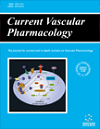- Home
- A-Z Publications
- Current Vascular Pharmacology
- Previous Issues
- Volume 2, Issue 1, 2004
Current Vascular Pharmacology - Volume 2, Issue 1, 2004
Volume 2, Issue 1, 2004
-
-
Glucocorticoids and Vascular Reactivity
More LessAuthors: Shumei Yang and Lubo ZhangCorticosteroid hormones play an important role in the control of vascular smooth muscle tone by their permissive effects in potentiating vasoactive responses to catecholamines through glucocorticoid receptors. Increased cortisol response has been associated with an increase in arterial contractile sensitivity to norepinephrine and vascular resistance. Glucocorticoids regulate vascular reactivity by acting on both endotheli Read More
-
-
-
Continuous Elevation of Intracellular Ca2+ Is Essential for the Development of Cerebral Vasospasm
More LessAuthors: Eiichi Tani and Tsuyoshi MatsumotoSubarachnoid hemorrhage (SAH)-induced cerebral vasospasm causes serious neurological morbidity and mortality mainly because of the absence of effective treatment. Therefore, we reviewed the molecular mechanisms involved in the development of the cerebral vasospasm based on the experimental data in the two-hemorrhage canine model. The characteristic feature of vasospasm is a continuous elevation of intracellul Read More
-
-
-
Understanding the Mechanism of Platelet Thrombus Formation under Blood Flow Conditions and the Effect of New Antiplatelet Agents
More LessBy Shinya GotoPlatelet aggregation induced by stirring of a platelet suspension after activation by the exogenous addition of stimulants, such as ADP, epinephrine and thrombin, has long been used as a platelet function test, and for the screening of antiplatelet agents. Since platelet aggregation has been demonstrated to be mediated exclusively by the binding of plasma fibrinogen to the activated GP IIb / IIIa, anti-GP IIb / IIIa agents, which Read More
-
-
-
Fibroblast Growth Factor 2: From Laboratory Evidence to Clinical Application
More LessAuthors: Chu-Huang Chen, Simon M. Poucher, Jonathan Lu and Philip D. HenryFibroblast growth factor 2 (FGF2) is expressed ubiquitously in mesodermal and neuroectodermal cells. Human FGF2 occurs in isoforms translated from a common mRNA by alternative use of AUG (low-molecular weight isoforms) and CUG (high-molecular weight isoforms) start codons. Whereas the high-molecular weight isoforms function in an intracrine manner, the low-molecular weight isoform functions as autocrine, Read More
-
-
-
Hypercholesterolemia and Endothelium Dysfunction: Role of Dietary Supplementation as Vascular Protective Agents
More LessAuthors: L. Boak and J. P.F. Chin-DustingThere is increasing evidence that dietary supplementation, such as L-arginine, anti-oxidant vitamins, soy phytoestrogens, flavonoids and omega-3 fatty acids exert vascular protective benefits particularly in terms of restoring endothelial function in cardiovascular disease states. The endothelium has been a major focus over the past 20 years as being a primary site at which dysfunction occurs in association with, and Read More
-
-
-
Effects of Endothelins on Cardiac and Vascular Cells: New Therapeutic Target for the Future?
More LessAuthors: Attila Mohacsi, Janos Magyar, Tamas Banyasz and Peter P. NanasiThe predominant isoform of the endothelin peptide family, endothelin-1 (ET-1) exerts various biological effects. These include effects on arterial smooth muscle cells causing intense vasoconstriction and stimulation of cardiac cells. ET-1 promotes changes in cardiomyocytes that are consistent with electrical remodelling such as changes in ionic current density and inhomogeneous prolongation of action potential duration resulti Read More
-
-
-
Pharmacological Modulations of the Renin-Angiotensin-Aldosterone System in Human Congestive Heart Failure: Effects on Peripheral Vascular Endothelial Function
More LessElevated peripheral vascular tone has been proposed as one of the detrimental factors causing increased cardiac after load and reduced exercise capacity in patients with congestive heart failure (CHF). A number of studies have shown impaired endothelium-dependent vasodilation in limb resistance and conduit vessels in CHF, suggesting that this is one of the important etiologies of vascular dysfunction. Several clinical trial Read More
-
-
-
Cardiovascular Control After Spinal Cord Injury
More LessAuthors: F. A.A. Gondim, A. C.A. Lopes Jr., G. R. Oliveira, C. L. Rodrigues, P. R.L. Leal, A. A. Santos and F. H. RolaSpinal cord injury (SCI) leads to profound haemodynamic changes. Constant outflows from the central autonomic pattern generators modulate the activity of the spinal sympathetic neurons. Sudden loss of communication between these centers and the sympathetic neurons in the intermediolateral thoracic and lumbar spinal cord leads to spinal shock. After high SCI, experimental data demonstrated a brief hyperte Read More
-
-
-
Biological Nitration of Arachidonic Acid
More LessAuthors: Michael Balazy and Candace D. PoffWhen a spontaneous autoxidation of arachidonic acid to prostaglandin-like products was first described almost 40 years ago, it was thought to be an artifact that interfered with the detection of enzymatically generated prostaglandins. It has now been generally accepted that the autoxidation of arachidonic acid occurs in vivo and leads to formation of isoprostanes and other products. Sensitive methods can detect the isoprosta Read More
-
Volumes & issues
-
Volume 23 (2025)
-
Volume 22 (2024)
-
Volume 21 (2023)
-
Volume 20 (2022)
-
Volume 19 (2021)
-
Volume 18 (2020)
-
Volume 17 (2019)
-
Volume 16 (2018)
-
Volume 15 (2017)
-
Volume 14 (2016)
-
Volume 13 (2015)
-
Volume 12 (2014)
-
Volume 11 (2013)
-
Volume 10 (2012)
-
Volume 9 (2011)
-
Volume 8 (2010)
-
Volume 7 (2009)
-
Volume 6 (2008)
-
Volume 5 (2007)
-
Volume 4 (2006)
-
Volume 3 (2005)
-
Volume 2 (2004)
-
Volume 1 (2003)
Most Read This Month
Article
content/journals/cvp
Journal
10
5
false
en


